In recent years, vinyl records have made a remarkable comeback, captivating music enthusiasts with their warm, rich sound and tangible connection to the past.
According to recent statistics, vinyl sales in 2024 have continued to surge, with a 15% increase from the previous year.
This resurgence has led many music lovers to dust off their old turntables or invest in new ones, eager to experience their favorite albums in this classic format.
Wondering about speakers for your turntable? Check out Do Record Players Need Speakers? What to Know About Turntable Audio Setup.
However, as more people embrace vinyl, a common challenge has emerged: how to integrate these vintage audio devices with modern sound systems, particularly soundbars.
Many vinyl enthusiasts find themselves asking, “Why doesn’t my turntable work with my new soundbar?”
This disconnect between old and new technology can be frustrating, potentially dampening the excitement of rediscovering vinyl.
Fortunately, connecting a turntable to a soundbar is not only possible but can be achieved through various methods, catering to both basic and advanced setups.
This comprehensive guide will walk you through everything you need to know about bridging the gap between your turntable and soundbar.
We’ll cover essential concepts, equipment requirements, step-by-step connection methods, troubleshooting tips, and even product recommendations to ensure you get the best possible sound from your vinyl collection through your modern audio setup.
Become an Acoustics Insider!
Gain access to expert insights on acoustic panels, soundproofing, soundbars, DJ controllers, MIDI setups, turntables, and more—plus exclusive tips and gear recommendations to perfect your audio world.
We value your privacy—unsubscribe anytime, no spam ever, using the link in our newsletter.
How to Connect a Turntable to a Soundbar?
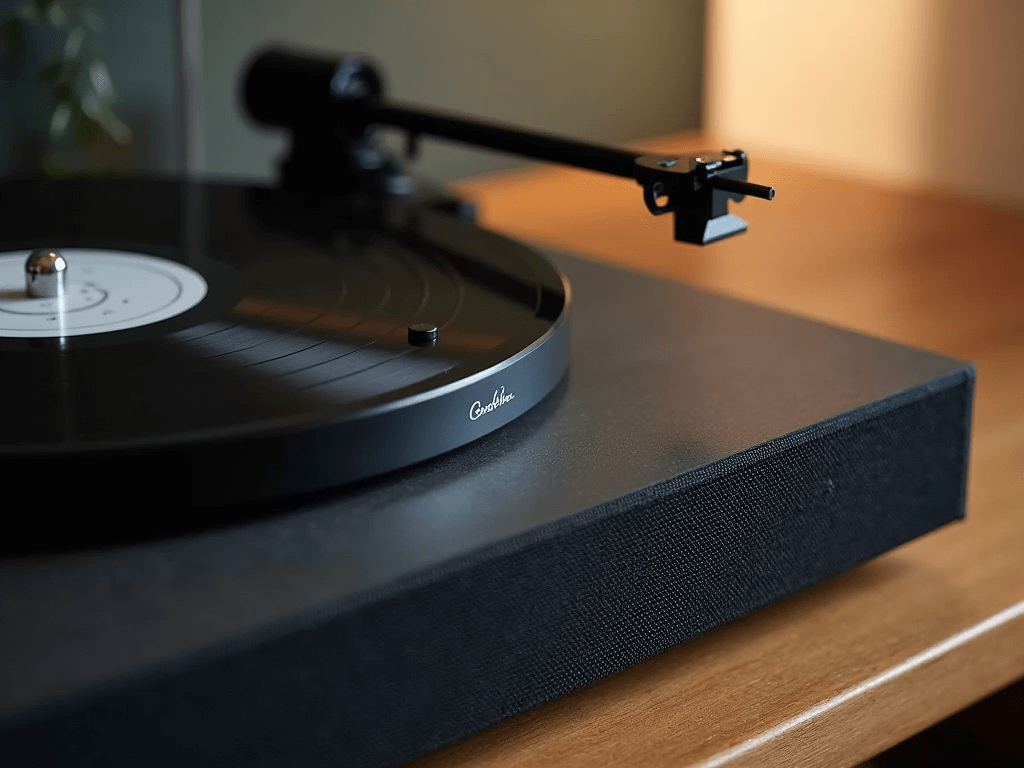
To connect a turntable to a soundbar, first ensure your turntable has a built-in phono preamp or use an external phono preamp.
Connect the turntable’s RCA outputs to the soundbar’s analog inputs using RCA cables.
If your soundbar lacks RCA inputs, use an RCA to 3.5mm adapter to connect to the auxiliary input.
For wireless connection, use a Bluetooth transmitter connected to the turntable’s output.
Select the corresponding input on your soundbar and adjust the volume.
This guide will delve deeper into each method, offering step-by-step instructions and troubleshooting tips to optimize your vinyl listening experience through a soundbar.
Understanding Turntable and Soundbar Compatibility: Essential Knowledge

Before diving into the specifics of connecting your turntable to a soundbar, it’s crucial to understand a few key concepts that will inform your setup choices and help you troubleshoot any issues that may arise.
Phono Preamp Basics
A phono preamp, also known as a phono stage, is an essential component in most turntable setups.
Its primary function is to amplify the weak electrical signal produced by the turntable’s cartridge to a level that can be processed by standard audio equipment.
Additionally, a phono preamp applies the RIAA equalization curve, which is necessary to accurately reproduce the sound as it was intended when the record was mastered.
Most modern turntables come with a built-in phono preamp, which simplifies the connection process.
However, many audiophiles prefer external phono preamps for their superior sound quality and customization options.
To determine if your turntable has a built-in preamp, check the manufacturer’s specifications or look for a switch labeled “PHONO/LINE” on the turntable itself.
If your turntable doesn’t have a built-in preamp, you’ll need to purchase an external one to connect it to a soundbar or any other audio device that lacks a dedicated phono input.
Wondering about receivers instead? Learn more in our guide, Do I Need a Receiver for My Turntable? A Complete Guide.
This additional component ensures that your vinyl records sound their best and prevents potential damage to your audio equipment from improperly amplified signals.
Soundbar Input Types
Soundbars come with various input options, each with its own advantages and limitations when it comes to connecting a turntable.
Understanding these input types will help you choose the most suitable connection method for your setup.
RCA (Analog) inputs are the most straightforward option for connecting a turntable to a soundbar.
These red and white connectors provide a direct analog connection, preserving the authentic vinyl sound.
The main limitation of RCA connections is cable length, as longer cables can introduce noise and signal degradation.
HDMI/ARC (Audio Return Channel) inputs are common on modern soundbars and offer high-quality digital audio transmission.
While not directly compatible with turntables, HDMI connections can be used with the help of an analog-to-digital converter.
This method allows for a clean setup but may introduce a slight delay in audio processing.
Bluetooth connectivity is available on many contemporary soundbars, offering a wireless solution for turntable connection.
While convenient, Bluetooth can result in some loss of audio quality due to compression. Additionally, not all turntables have built-in Bluetooth capabilities, so an external transmitter may be necessary.
Optical (TOSLINK) inputs are another digital option found on some soundbars. Like HDMI, optical connections require an analog-to-digital converter to work with turntables.
They provide excellent sound quality but may not support the highest resolution audio formats.
Auxiliary (3.5mm) inputs are less common on soundbars but can be used with turntables via an RCA-to-3.5mm adapter.
This method is simple but may not provide the best audio quality compared to dedicated RCA inputs.
Understanding these input types will help you determine the best connection method for your specific turntable and soundbar combination, ensuring optimal sound quality and ease of use.
Essential Gear for Connecting Your Turntable to a Soundbar: What You Need
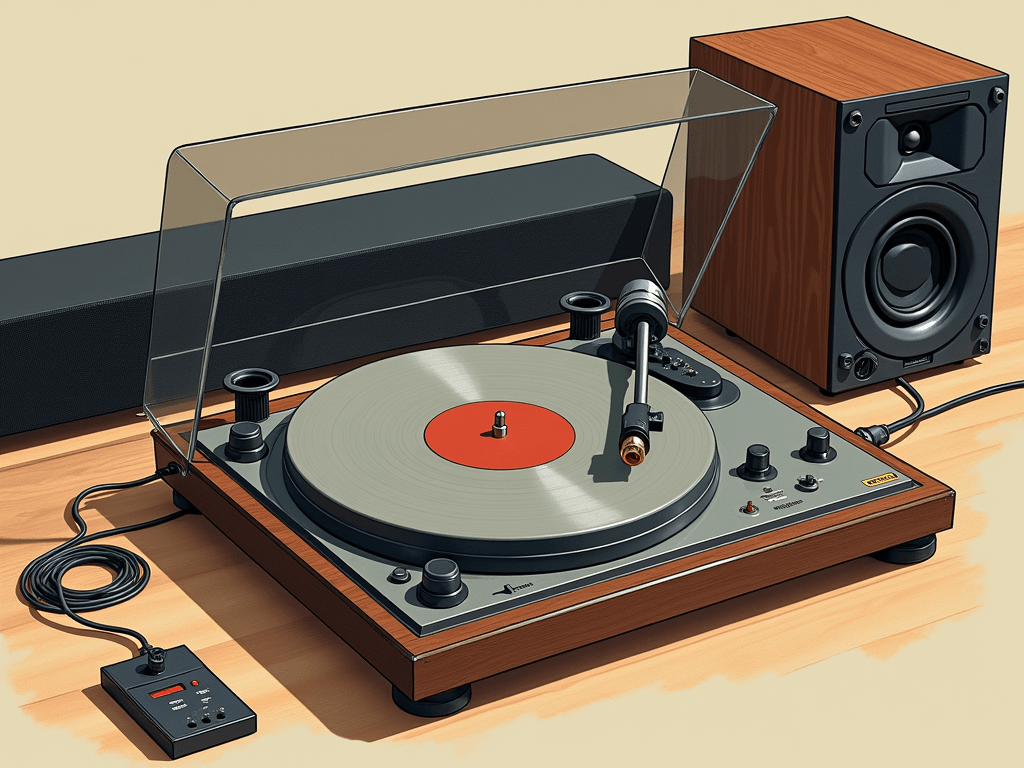
To successfully connect your turntable to a soundbar, you’ll need to gather the right equipment.
This section will cover both essential components and optional upgrades that can enhance your vinyl listening experience.
Essential Components
RCA cables are the primary means of connecting most turntables to audio equipment.
When selecting RCA cables, opt for high-quality, gold-plated connectors to ensure the best possible signal transmission.
Gold-plated connectors resist corrosion and provide excellent conductivity, resulting in clearer sound and reduced interference.
A phono preamp is crucial if your turntable doesn’t have one built-in or if you prefer the flexibility of an external unit.
There are two main types of external phono preamps: inline and standalone. Inline preamps are compact devices that connect directly between your turntable and soundbar, offering a simple plug-and-play solution.
Standalone preamps are larger, separate units that often provide more advanced features and potentially better sound quality.
A ground wire is essential for many turntable setups to eliminate unwanted hum or buzz in the audio signal.
This thin wire connects the turntable’s chassis to the phono preamp or receiver’s ground terminal. Not all turntables require a separate ground wire, as some models incorporate grounding into their RCA cables.
For a broader perspective on amplification options, check out Do I Need a Receiver for My Turntable? A Complete Guide.
Optional Upgrades
For those looking to enhance their setup or overcome specific challenges, there are several optional upgrades to consider.
Wireless transmitter kits can be a game-changer if you want to position your turntable away from your soundbar or eliminate cable clutter.
These kits typically consist of a transmitter that connects to your turntable and a receiver that plugs into your soundbar, allowing for wireless audio transmission.
A Digital-to-Analog Converter (DAC) can be beneficial when connecting a turntable to a soundbar with only digital inputs, such as HDMI or optical.
A high-quality DAC ensures that the analog signal from your turntable is accurately converted to digital format without losing the warmth and detail that vinyl is known for.
Consider investing in a stylus brush and record cleaning kit to maintain your vinyl collection and ensure optimal sound quality.
Regular cleaning of both your records and turntable stylus can significantly extend the life of your equipment and improve audio performance.
Vibration isolation pads or a dedicated turntable stand can help minimize unwanted vibrations that can affect sound quality, especially if your turntable is placed near your soundbar or on an unstable surface.
These accessories can make a noticeable difference in the clarity and detail of your vinyl playback.
By ensuring you have the right equipment on hand, you’ll be well-prepared to connect your turntable to your soundbar and start enjoying your vinyl collection through your modern audio setup.
How to Connect Your Turntable to a Soundbar: Step-by-Step Guide
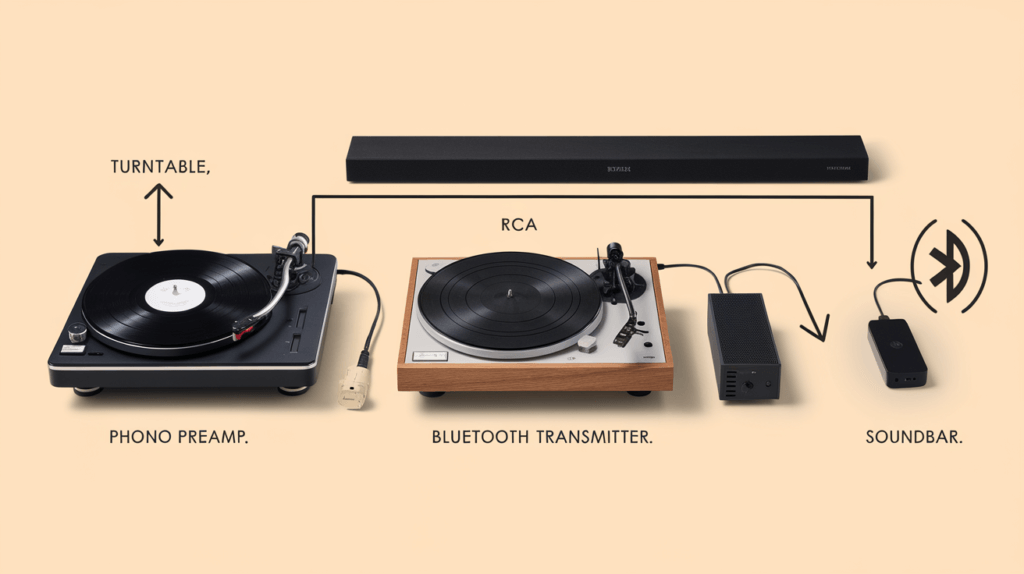
Now that we’ve covered the essential concepts and equipment, let’s dive into the step-by-step process of connecting your turntable to your soundbar.
We’ll explore three primary methods: direct RCA connection, using a phono preamp, and wireless solutions.
Method 1: Direct RCA Connection
This method is suitable for turntables with built-in phono preamps and soundbars with analog RCA inputs.
Begin by locating the analog inputs on your soundbar. These are typically labeled as “AUX IN” or “AUDIO IN” and consist of red and white RCA ports.
Next, take your RCA cables and connect them to the output jacks on your turntable.
The red connector goes to the right channel (usually marked “R”), and the white connector goes to the left channel (usually marked “L”).
Ensure the connections are firm to avoid any loose contacts that could cause audio issues.
Now, connect the other end of the RCA cables to the corresponding inputs on your soundbar. Again, match the red connector to the red input and the white connector to the white input.
If your turntable has a ground wire, connect it to the ground terminal on your soundbar if available.
If your soundbar doesn’t have a dedicated ground terminal, you may need to use the metal chassis of the soundbar or a nearby metal object as a grounding point.
Once all connections are secure, power on both your turntable and soundbar. Select the appropriate input on your soundbar (usually labeled as AUX or ANALOG) and start playing a record.
You should now hear the audio coming through your soundbar.
Method 2: Using a Phono Preamp
If your turntable doesn’t have a built-in phono preamp, or if you prefer to use an external phono preamp for better sound quality, follow these steps.
Start by placing your phono preamp between the turntable and the soundbar. The general signal flow should be: Turntable → Phono Preamp → Soundbar.
Connect the RCA cables from your turntable’s output to the input of the phono preamp. If your turntable has a ground wire, connect it to the ground terminal on the phono preamp.
Next, use another set of RCA cables to connect the output of the phono preamp to the analog inputs on your soundbar.
Power on all devices: the turntable, phono preamp, and soundbar. Select the appropriate input on your soundbar and begin playback of a record.
You may need to adjust the volume levels on both the phono preamp and the soundbar to achieve the desired sound.
For optimal performance, it’s important to calibrate the volume levels properly. Start with the volume on your soundbar at a low level and gradually increase it while playing a record.
Adjust the output level on your phono preamp (if it has this feature) to find the sweet spot where the audio is clear and undistorted, even at higher volumes.
Method 3: Wireless Solutions
For those who prefer a cable-free setup or need to place their turntable far from the soundbar, wireless solutions offer a convenient alternative. The most common wireless method involves using a Bluetooth transmitter.
For advanced wireless setups with Sonos, explore How to Connect a Turntable to Sonos.
To set up a wireless connection, first, plug a Bluetooth transmitter into your turntable’s audio output. If your turntable has a built-in phono preamp, you can connect the transmitter directly.
If not, you’ll need to connect a phono preamp between the turntable and the Bluetooth transmitter.
Next, power on the Bluetooth transmitter and put it into pairing mode. On your soundbar, activate Bluetooth pairing mode as well.
Consult your soundbar’s manual for specific instructions on how to do this, as it can vary between models.
Once the devices are paired, select the Bluetooth input on your soundbar. Play a record on your turntable, and you should hear the audio coming through your soundbar wirelessly.
Keep in mind that Bluetooth audio may introduce a slight delay, which is usually not noticeable when listening to music but could be apparent if you’re watching the record spin.
If you experience any latency issues, some Bluetooth transmitters offer low-latency modes or support for advanced codecs like aptX Low Latency. Check your transmitter’s settings to see if these options are available.
By following these step-by-step guides, you should be able to successfully connect your turntable to your soundbar using the method that best suits your equipment and preferences.
Remember to test your setup with different records and adjust as necessary to achieve the best possible sound quality.
Solving Turntable to Soundbar Connection Problems: Troubleshooting Guide

Even with careful setup, you may encounter some issues when connecting your turntable to your soundbar.
This section will address common problems and provide both quick fixes and more advanced solutions.
One of the most frequent issues is a persistent hum or buzz in the audio. This is often caused by a ground loop or improper grounding.
As a quick fix, ensure that your ground wire is securely connected if your setup includes one. If the problem persists, try using a ferrite choke on your RCA cables.
These small, clip-on devices can help reduce electromagnetic interference that causes unwanted noise.
Low volume is another common complaint, especially when using a turntable without a built-in preamp.
First, check if your soundbar has a phono input mode and ensure it’s enabled. If this doesn’t solve the issue, consider adding a standalone preamp to boost the signal strength.
Make sure to match the preamp’s output level with your soundbar’s input sensitivity for optimal results.
If you’re not getting any sound at all, start by verifying that you’ve selected the correct input on your soundbar.
It’s easy to overlook this simple step, especially if your soundbar has multiple input options. If the input selection is correct, test your soundbar with a different audio source to determine if the issue is with the turntable connection or the soundbar itself.
For setups using a Bluetooth connection, intermittent dropouts or poor audio quality can be frustrating.
Try moving the Bluetooth transmitter closer to the soundbar to improve signal strength.
If possible, ensure there are no large metal objects or other sources of interference between the transmitter and receiver.
Upgrading to a Bluetooth 5.0 or higher transmitter can also provide better range and stability.
Sometimes, you may notice distortion in the audio, particularly at higher volumes. This could be due to a mismatched output level between your turntable (or preamp) and the soundbar’s input.
Gradually adjust the volume levels on both devices to find a balance that provides clear, undistorted sound.
If the distortion persists, check your turntable’s stylus for wear or damage, as this can also cause audio issues.
If you’re experiencing a lack of bass or treble, first check if your soundbar has EQ settings and adjust them accordingly.
For vinyl enthusiasts seeking a more authentic sound, consider disabling any digital sound processing modes on your soundbar, as these can alter the natural characteristics of vinyl playback.
In cases where you hear static or crackling, especially during quiet passages, dust on your records or a worn stylus might be the culprit.
Regularly clean your records with a carbon fiber brush before playing, and consider upgrading your stylus if it’s old or showing signs of wear.
For more complex setups involving multiple components, signal chain issues can be tricky to diagnose. Systematically test each component individually to isolate the problem.
Start with the turntable and work your way through each connection point until you identify the source of the issue.
Remember that some soundbars may not be optimized for the wide dynamic range of vinyl records. If you find that your setup struggles with very quiet or very loud passages, you might want to consider adding a compressor/limiter to your signal chain.
This can help even out the volume levels for a more consistent listening experience.
Lastly, if you’re using a wireless setup and experiencing significant audio delay, check if your Bluetooth transmitter supports aptX Low Latency or similar technologies.
Switching to a wired connection might be necessary if the latency issues persist and are bothersome during your listening sessions.
By addressing these common issues, you can ensure that your turntable and soundbar setup provides the best possible vinyl listening experience.
Don’t hesitate to experiment with different settings and configurations to find what works best for your specific equipment and preferences.
Best Equipment for Turntable to Soundbar Setups: Top Picks and Reviews
To help you get the most out of your turntable and soundbar setup, we’ve compiled a list of recommended products that can enhance your vinyl listening experience.
These selections are based on performance, features, and value for money.
In the category of best soundbars for vinyl enthusiasts, the Klipsch Cinema 400 stands out for its analog RCA inputs.
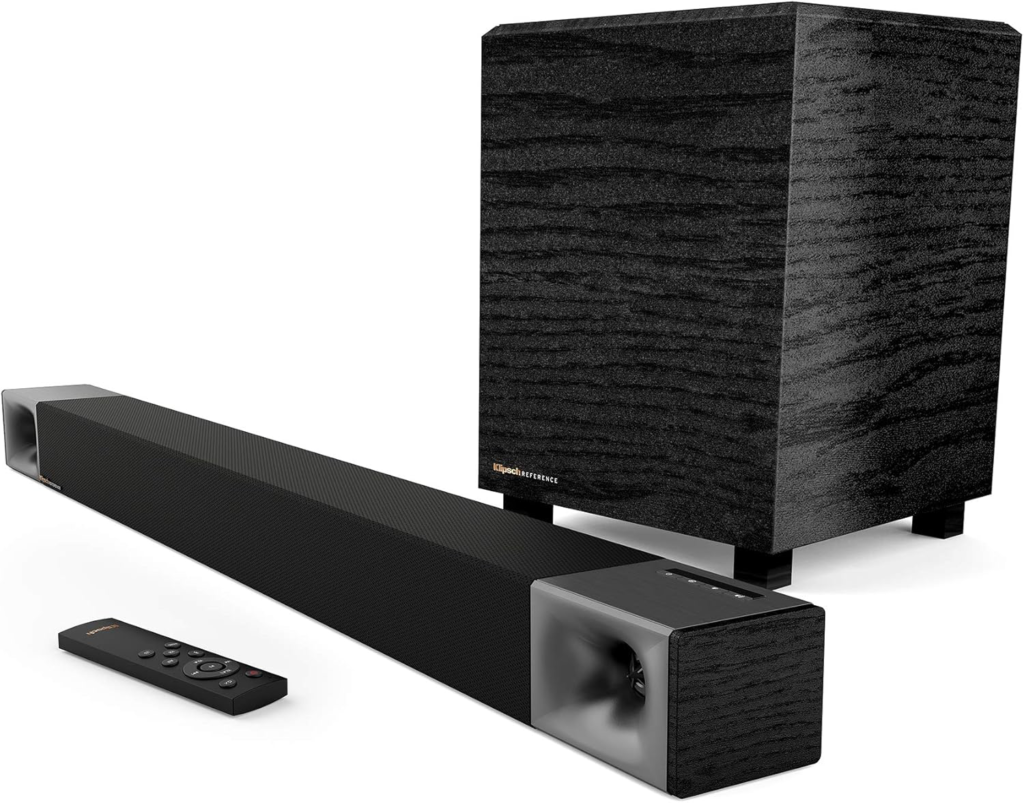
Klipsch Cinema 400 Soundbar
For vinyl lovers and movie buffs alike, the Klipsch Cinema 400 offers RCA inputs and a wireless subwoofer for crisp sound and powerful bass—perfect for any setup.
Check Price On AmazonThis feature allows for direct connection of a turntable with a built-in phono preamp, simplifying your setup while maintaining excellent sound quality.
The Cinema 400 also offers a wireless subwoofer for enhanced bass response and a sleek design, making it a versatile choice for both vinyl playback and modern home theater needs.
Its horn-loaded tweeters, a signature Klipsch technology, deliver clear and detailed high frequencies, which can help reproduce the warmth and nuance of vinyl recordings.
While it may not have built-in smart features like voice control, the Cinema 400 focuses on delivering high-quality audio performance, making it an attractive option for those prioritizing sound over additional tech features in their vinyl listening setup.
This feature allows for direct connection of a turntable without the need for an external preamp, simplifying your setup while maintaining excellent sound quality.
For those with existing soundbars that lack analog inputs, the Sonos Beam (Gen 2) is an excellent option when paired with the Sonos Port.
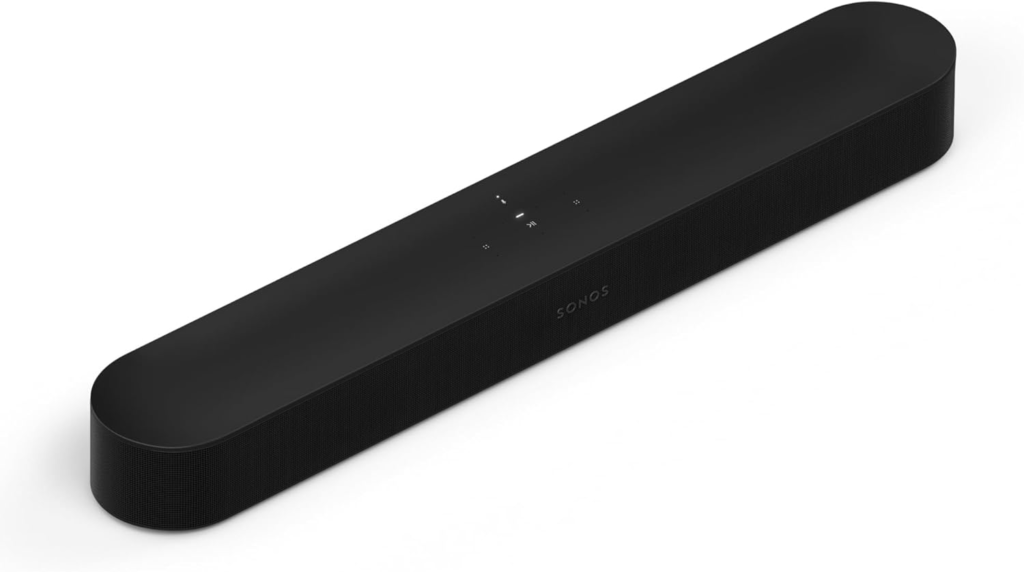
Sonos Beam (Gen 2) Soundbar
Elevate your vinyl and home audio with the Sonos Beam (Gen 2)—pair it with Sonos Port for seamless turntable integration and enjoy rich sound with multi-room control.
Check Price On AmazonWhile the Beam itself doesn’t have analog inputs, the Sonos Port acts as a bridge, allowing you to connect your turntable to the Sonos ecosystem.
This combination provides exceptional sound quality and the flexibility to expand your whole-home audio system in the future.
For a deeper dive into integrating a turntable with Sonos, read our guide on How to Connect a Turntable to Sonos.
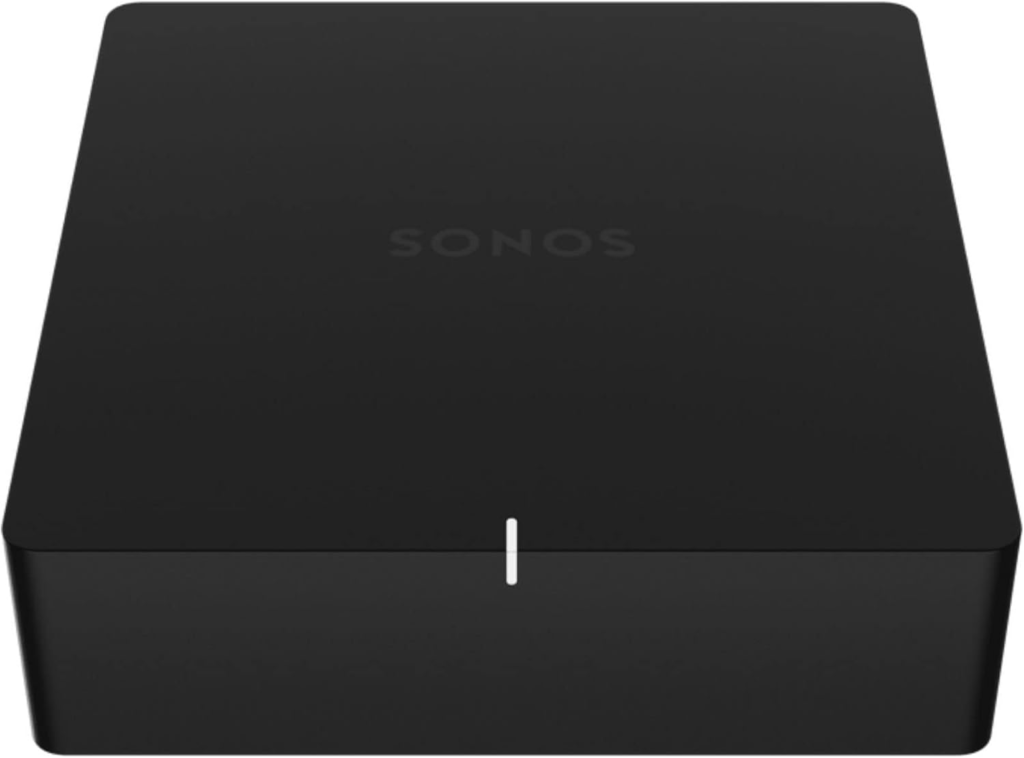
Sonos Port
Transform your turntable setup with the Sonos Port—seamlessly connect to the Sonos ecosystem with high-quality audio processing and multi-room flexibility.
Check Price On AmazonWhen it comes to budget-friendly phono preamp options, the Pyle PP444 offers great value for beginners.

Pyle PP444
Perfect for beginners, the Pyle PP444 delivers clean, noise-free amplification—ideal for connecting turntables to soundbars or audio systems affordably.
Check Price On AmazonIt provides a clean, noise-free amplification of your turntable’s signal at an affordable price point.
Pair it with a capable Bluetooth transmitter like the 1Mii B06TX for a reliable wireless vinyl listening experience.

1Mii B06Pro+
Enhance your audio setup with the 1Mii B06Pro+—low latency, long-range Bluetooth with aptX HD support, perfect for wireless streaming from turntables to soundbars.
Check Price On AmazonConclusion
Connecting a turntable to a soundbar bridges the gap between classic vinyl and modern audio technology, allowing you to enjoy the warm, rich sound of records through your contemporary home audio setup.
While it may require some additional equipment and setup, it’s a viable solution for those looking to integrate their vinyl collection with their existing home theater system.
Remember that the key components for a successful setup are:
- A good phono preamp (if not built into your turntable)
- The right cables or adapters
- Possibly an analog-to-digital converter or Bluetooth transmitter, depending on your soundbar’s inputs
As you embark on your vinyl journey with a soundbar, keep in mind that experimentation is part of the process.
Don’t be afraid to try different setups and adjust settings to find the sweet spot for your listening preferences.
While a soundbar may not replicate the exact experience of a high-end stereo system, it can still provide an enjoyable and convenient way to rediscover the warmth and character of vinyl records in your modern living space.
Whether you’re a vinyl veteran or just starting your collection, the combination of a turntable and soundbar offers a unique blend of nostalgia and contemporary convenience.
Embrace the process, enjoy the music, and let the distinctive crackle of vinyl transport you to a world of rich, analog sound—right from your sleek, digital soundbar setup.
Remember, the goal is to enjoy your music. If your setup sounds good to you, then you’ve succeeded. Happy listening!
For more on turntable audio setups, including speakers, read Do Record Players Need Speakers? What to Know About Turntable Audio Setup.
